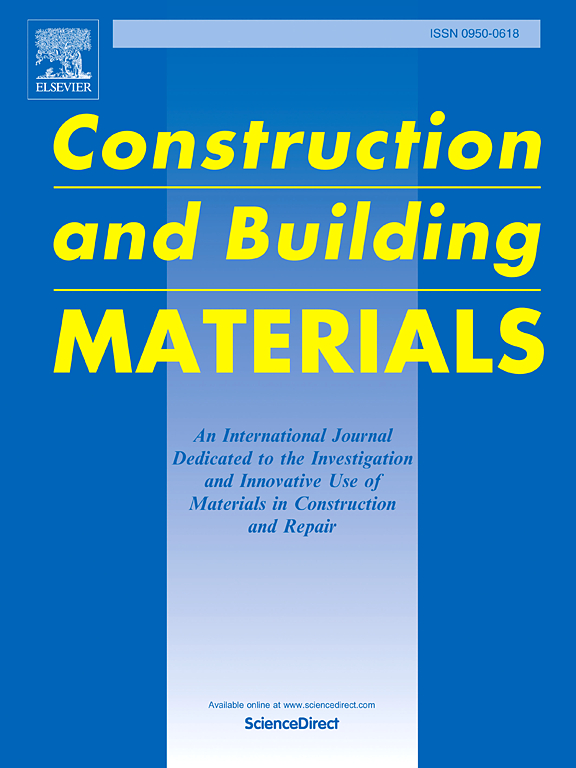利用废焚烧灰开发低碳水泥:力学性能、水化行为和环境影响
IF 7.4
1区 工程技术
Q1 CONSTRUCTION & BUILDING TECHNOLOGY
引用次数: 0
摘要
利用城市生活垃圾焚烧灰(飞灰和底灰)开发低碳水泥对固体废物管理和减少碳排放至关重要。采用超声加速碳化法对生FA进行预处理,并引入超声辅助碳化粉煤灰(UFA)制备新型UFA- ba水泥(UBC)。UBC膏体具有优良的抗压强度(33.2 MPa)和抗氯离子渗透性能。UFA和BA均具有稀释和填充作用,其中UFA显著增强了UBC的早期水化反应(0-1 小时)。这显著提高了早期固化UBC浆料的聚合度,形成致密的微观结构。石膏或CaO(2.5 %和5 %)的加入对UBC水泥体系有负面影响。水泥熟料比从50% %降低到40% %,显著降低了膏体强度。另外,BA中的氯盐与CaCO3反应形成不溶性氯盐Tunisite (NaCa2Al4(CO3)4(OH)8Cl),进一步强化了水泥结构。As、Ba、Cr、Cu、Ni、Pb、Se、Zn的浸出浓度均低于中国地下水ⅳ级标准。根据生命周期评估,UBC方案的二氧化碳排放量最少(322 kg-CO2当量),比普通水泥低53.6 %。因此,尽管UBC的抗压强度低于普通水泥(PC),但其在碳减排、环境性能和资源回收方面的显著优势使其成为非结构和半结构应用中有前景的低碳替代品,支持FA的可持续利用。本文章由计算机程序翻译,如有差异,请以英文原文为准。
Development of low-carbon cement utilizing waste incineration ash: Mechanical properties, hydration behavior, and environmental impact
Developing low-carbon cement from municipal solid waste incineration ash (fly ash (FA) and bottom ash (BA)) is vital for solid waste management and reducing carbon emission. Raw FA was pretreated by ultrasonic accelerated carbonation and ultrasound-assisted carbonated fly ash (UFA) was introduced to create a novel UFA-BA-cement (UBC). The UBC paste demonstrated excellent compressive strength (33.2 MPa) and resistance to chloride penetration due to its refined pore structure. Both UFA and BA exhibited dilution and filling effects, with UFA notably enhancing the early hydration reaction (0–1 hour) of UBC. This significantly increased the polymerization degree of the early curing UBC paste, resulting in a dense microstructure. The addition of gypsum or CaO (2.5 % and 5 %) has a negative effect on the UBC cement system. Reducing the cement clinker ratio from 50 % to 40 % significantly weakened the paste strength. Additionally, the chloride salts in BA reacted with CaCO3, forming insoluble chloride salt Tunisite (NaCa2Al4(CO3)4(OH)8Cl), which further strengthened cement structure. The leaching concentrations of As, Ba, Cr, Cu, Ni, Pb, Se, and Zn are all lower than the Chinese groundwater grade IV standard. According to life cycle assessment, the UBC scenario emits the least CO2 (322 kg-CO2 eq.), which is 53.6 % lower than that of plain cement. Therefore, although the compressive strength of UBC is lower than that of plain cement (PC), its significant advantages in carbon emission reduction, environmental performance, and resource recovery make it a promising low-carbon alternative for non-structural and semi-structural applications, supporting the sustainable utilization of FA.
求助全文
通过发布文献求助,成功后即可免费获取论文全文。
去求助
来源期刊

Construction and Building Materials
工程技术-材料科学:综合
CiteScore
13.80
自引率
21.60%
发文量
3632
审稿时长
82 days
期刊介绍:
Construction and Building Materials offers an international platform for sharing innovative and original research and development in the realm of construction and building materials, along with their practical applications in new projects and repair practices. The journal publishes a diverse array of pioneering research and application papers, detailing laboratory investigations and, to a limited extent, numerical analyses or reports on full-scale projects. Multi-part papers are discouraged.
Additionally, Construction and Building Materials features comprehensive case studies and insightful review articles that contribute to new insights in the field. Our focus is on papers related to construction materials, excluding those on structural engineering, geotechnics, and unbound highway layers. Covered materials and technologies encompass cement, concrete reinforcement, bricks and mortars, additives, corrosion technology, ceramics, timber, steel, polymers, glass fibers, recycled materials, bamboo, rammed earth, non-conventional building materials, bituminous materials, and applications in railway materials.
 求助内容:
求助内容: 应助结果提醒方式:
应助结果提醒方式:


